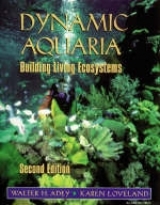
Dynamic Aquaria
Academic Press Inc (Verlag)
978-0-12-043790-0 (ISBN)
- Titel erscheint in neuer Auflage
- Artikel merken
"Dynamic Aquaria" is the outgrowth of years of research aimed at studying how to accurately model and construct living ecosystems in mesocosms, mircrocosms, and aquaria. It presents scientifically sound information for a growing new area of science, synthetic ecology, or the construction of living ecosystems. At the same time, the authors present thoughtful perspectives on how the knowledge gained by creating these smaller ecosystems helps us to understand our wild ecosystems and biosphere as a whole. The book presents new concepts that will provide scientists, professional aquarists, and hobbyists with the opportunity to learn how to more closely approximate natural ecosystems in closed, artificial environments. It covers the interactions of the physical and biochemical environments as they relate to various size model systems and their natural counterparts. The book also introduces a core ecological concept - the food web - into aquarium science and discusses some of the food web and the community structure are compressed into a limited space.
Several model ecosystems, ranging in size from the Great Barrier Reef Marine Park in Australia and Everglades mesocosm located at the Smithsonian Natural History Museum in Washington DC, to salt, brackish, and fresh water ecosystems of smaller aquarium size are discussed. For the scientist, this book presents an array of new approaches, some revolutionary, to the development and operation of experimental ecosystems. For the professional aquarist, this book demonstrates the ever-expanding possibilities for creating functioning ecosystems for educational display. For the hobbyist, it demonstrates the practical potential for building and operating true, "natural" ecosystems, rather than artifical habitats that house a few selected organisms. All the readers will benefit from the authors' discussions of how understanding these ecosystems and our ability to stimulate them increases our knowledge of ecology in general and of our biosphere in total.
Part 1 Introduction: social environment - the envelope - shapes, materials and construction; temperature - control of heating and colling; water composition - the management of salinity, hardness and evaporation; water motion - waves, currents and plumbing; tides - simulating the effects of sun and moon; the input of solar energy - light requirements; substrate - management of rock, mud and sand. Part 2 Biochemical environment: metabolism - respiration, photosynthesis, and biological loading; organisms and gas exchange - oxygen, carbon dioxide and pH; nitrogenous wastes and nutrients - nitrogen, phosphorus, and the micronutrients; control of the biochemical environment - filters, bacteria, and the algal turf scrubber. Part 3 Biological structure: community structure - the framework; trophic structure - ecosystems and the dynamics of food chains; primary producers - plants that gorw on the bottom; herbivores - predators of plants; carnivores - predators of animals; plankters and planktivores - the floating plants and animals and their predators; detritus and detritivores - the dynamics of muddy bottoms; other feeders - commensalism, symbiosis and parasitism. Part 4 Ecological systems in microcosms, mesocosms, and aquaria: models of coral reef ecosystems; a subarctic shore - the Maine coast; estuaries - ecosystem modelling where fresh and salt waters interact; freshwater ecosystem models; microcosms, mesocosms, and aquaria - a synthesis.
| Zusatzinfo | index |
|---|---|
| Verlagsort | San Diego |
| Sprache | englisch |
| Maße | 197 x 241 mm |
| Gewicht | 1325 g |
| Themenwelt | Sachbuch/Ratgeber ► Natur / Technik ► Tiere / Tierhaltung |
| ISBN-10 | 0-12-043790-2 / 0120437902 |
| ISBN-13 | 978-0-12-043790-0 / 9780120437900 |
| Zustand | Neuware |
| Haben Sie eine Frage zum Produkt? |
aus dem Bereich



